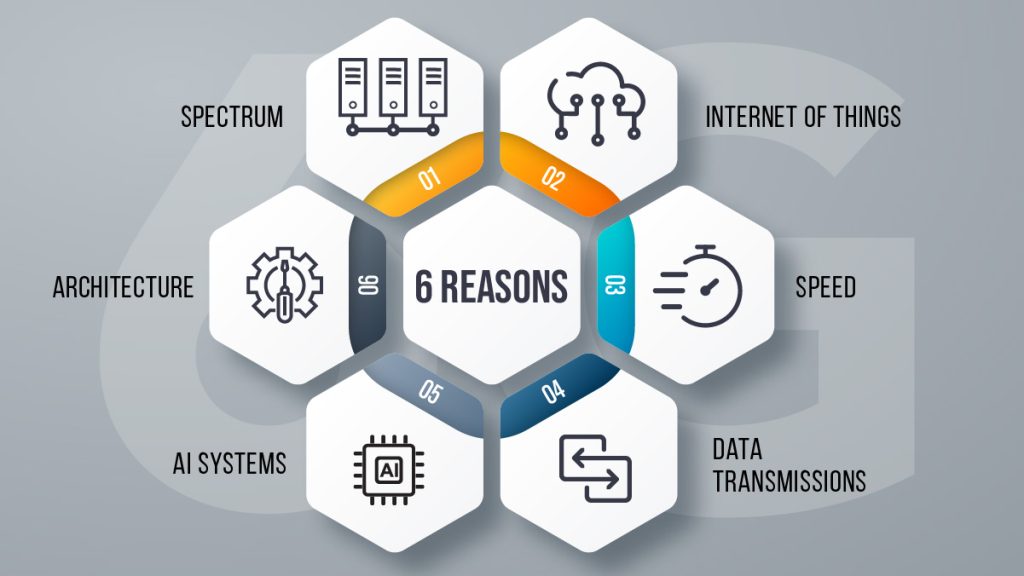
Connectivity is ever-evolving. Looking back, the first generation of mobile networks developed in 1979 in Japan seems so primitive now that we have 5 G rolling out and 6G in development. 5G, or the fifth generation of mobile networks, is a wireless mobile network designed to connect virtually everyone and everything, including machines, objects, and devices. Despite yet to fully roll 5G out, experts in the field are already working on the sixth generation (6G). The difference between 5G and 6G technology is subtle, and unless you are involved in the telecoms sector, you will not spot it immediately. Allow me to break them down for you.
The Spectrum Difference Between 5G and 6G
The main difference between 5G and 6G lies within the range of radio frequencies (RFs) they use, called a spectrum. These RFs are grouped into frequency bands defining upper and lower frequencies within each spectrum. 6G relies on higher frequency bands than 5G. the difference is so big that 5G is measured in Gigahertz (GHz) while 6G is in Terahertz (THz); one THz is 1000 GHz. The maximum frequency for 5G and 6G networks are 100 GHz and 10 THz, respectively. That is a remarkable difference.
Furthermore, the maximum bandwidth for each is 1 GHz and 100 GHz, respectively. This parameter represents the size of the band (the highest frequency minus the lowest). This parameter refers to the theoretical capacity of the network to transmit data since, in real life, certain aspects influence it, i.e., signal interference and the distance between the device and a wireless access point.
Latency
The time a packet of information takes to travel end-to-end is called latency. With every generation, these figure decrease. While 5G has a latency of 50 milliseconds (ms), 6G is shorter than 5G, with a figure ranging from 1 ms to 1 microsecond. As the primary intent for 6G is intelligent innovations, a short latency is a crucial feature of the 6G network.
Peak Data Rate Difference Between 5G and 6G Technology
Experts estimate that 6G will deliver a peak data rate of 1 THz. In layperson’s terms, data rate refers to the highest speed at which data may travel. Realistically, however, 6G internet coverage can not achieve these figures due to unpredictable environmental conditions. In contrast to 5G, with a data rate ranging from 10 Gbps (upload links) to 20 Gbps (download links), 6G networks’ peak data rate ranges between 100 Gbps to 1 Tbps. 6G speed is the top benefit of its implementation.
Artificial Intelligence (AI)
6G communication technology will combine edge computing with artificial intelligence to bring the server closer to the users from the cloud. Information and communications technology, as well as operational technology, will change significantly in the next generation. It is expected that 6G be equipped with context-aware algorithms optimizing its architecture, protocols, and operations. In contrast with 5G, 6G can fulfill the requirements for smart city mobile applications.
Architectural Difference Between 5G and 6G
6G can utilize 5G infrastructure, making its rollout quicker than 5G. Nevertheless, the architectures of 5G and 6G networks differ in several areas. 5 G relies on a dense sub-^ GHz smaller base station with umbrella macro base stations and is equipped with mmwave small cells of almost 100 meters for fixed access. 6G, however, uses cell-free smart surfaces at high frequencies. It also features temporary hotspots served by drone-mounted base stations or tethered balloons.
The Internet of Things (IoT)
While 5G networks are state-of-the-art, they present certain limitations that 6G networks are expected to overcome, one being the connection with IoT. 5G cannot adequately meet the requirements of the new smart applications. As a result, we see an increasing demand for envisioning 6G wireless communication systems. device-to-device (D2D), machine-to-machine (M2M) and vehicle-to-vehicle (V2V) communication technologies constitute the bulk of IoT applications. For that purpose, reliable data transmission with low latency, a key feature of 6G, is essential for successful IoT applications
Final Thoughts
At first glance, the difference between 5G and 6G networks is not apparent. And some people, especially those not versed in Telecom, would not see the added value of 6G outright. Nevertheless, this technology is crucial for the future of our smart cities. Its main benefit is its use in IoT and the like. A stable connection between devices could open new horizons in several sectors, most notably medtech. Can you imagine a smart implant for insulin? A diabetic patient would monitor it through an application. Still, the bulk of the work would be on that little device in their arm, including monitoring glucose levels and dispensing insulin as necessary. This seemingly inconspicuous innovation could make for a far more accessible world. 6G internet coverage could be a viable solution for a number of problems in several industries of the digital age.
Inside Telecom provides you with an extensive list of content covering all aspects of the tech industry. Keep an eye on our Connectivity section to stay informed and up-to-date with our daily articles.